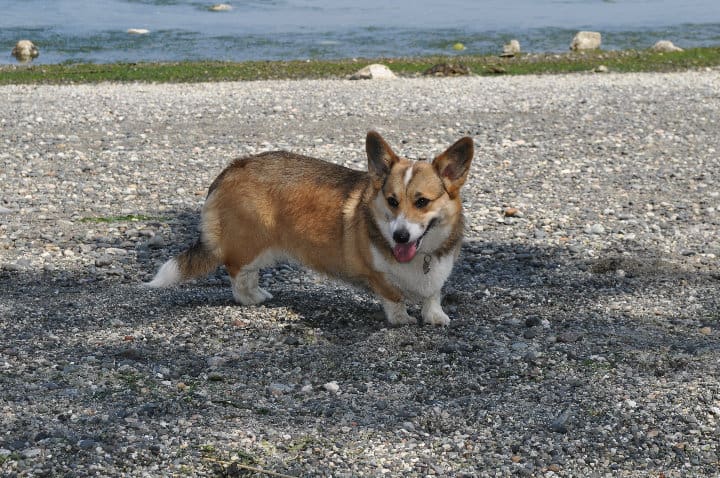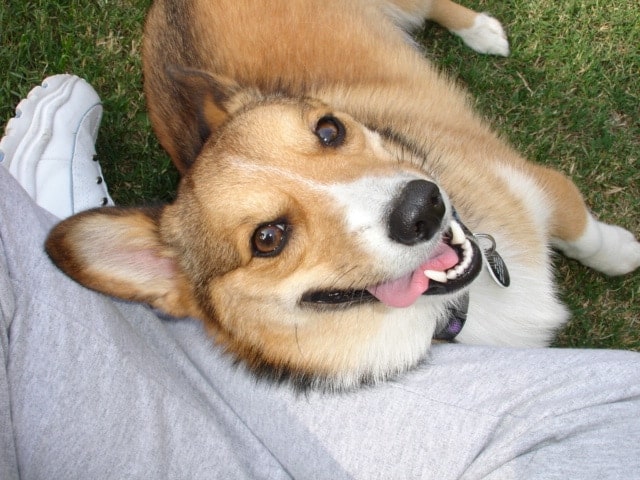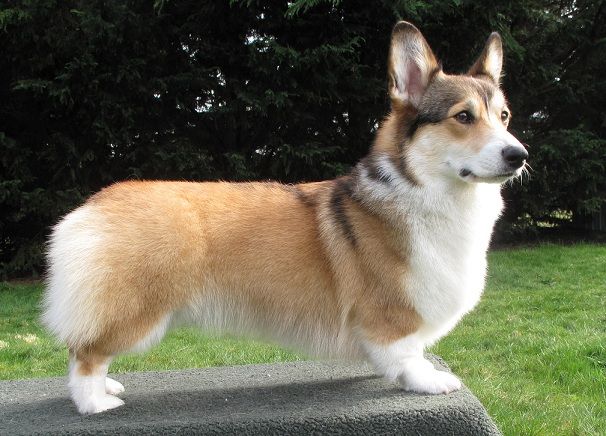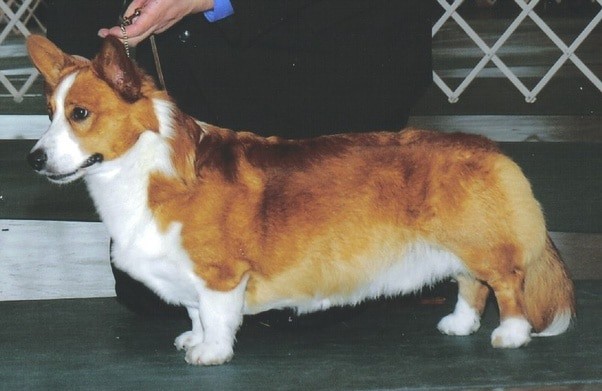Whether you love your corgi for her beautiful fluffy coat or her thick butt, there’s no denying the fact that this is a cute doggie.
If not for any of the two reasons, you are probably smitten by her wide cheeky grin and cute stumpy legs.
Queen Elizabeth (and other royals) agrees that corgis are amazing considering how she’s owned 30 members of the breed in her lifetime.
Rumor has it that no member of the royal family or anyone else is allowed to scold the pups no matter how they behave.
While we cannot confirm or deny the rumor, we know for sure that a corgi is worth owning.
Like other dog breeds, both the Pembroke Welsh and Cardigan corgis come in many colors. From red and white to sable to tri-colored varieties, the options are not limited.
In this guide, we will zoom in on the sable corgi. If you have a particular interest in color and want to own one, this post will come in handy.
Without further ado, here’s all you need to know before owning a sable corgi.
About The Breed
Corgis are some of the oldest breeds in the world, dating as far back as the 10th century. They are native to Wales where they were used to herd livestock.
The name corgi means a ‘dwarf dog” as they have stumpy feet that carry their bodies around. It is this very feature that gave corgis an edge over other dog breeds as far as herding is concerned.
Their short feet make them closer to the ground so they can have easy access to the ankles of livestock making them hard to be kicked.
Corgis come in two varieties: the Pembroke Welsh and Cardigan Welsh. Initially, the two were distinct breeds but after crossbreeding in the 19th century, they merged into one.
One of the easy ways to tell the varieties apart is by looking at the tail. The Pembroke essentially has no tail while the Cardigan has a fox-like curved tail.
Well, these days it is not uncommon to find Pembrokes with tails but they’ve been docked for the longest time.
Additionally, Cardigan Welsh corgis have rounded ears while their Pembroke counterparts have pointy ears.
As far as popularity is concerned, the Pembrokes are more popular (ranked number 11 by the American Kennel Club) than the Cardigans (ranked number 66 by the American Kennel Club).
What Does The Sable Corgi Look Like?

Both Pembroke and Cardigan corgis come in the sable color as well as other colors such as red and white, blackhead tri-color, fawn and white, redhead tri-color, black brindle, black with tan points, and blue brindles.
Generally, the sable color is a blend of many colors—mostly red, black, and brown. So, the term “sable” is often used to refer to a color pattern than actual coat color.
And it can be different from one breed to another except for one important feature: hair on a dog’s body tends to be lighter at the base of the coat than on the tip.
A sable corgi features red as the main color with the head and back being predominantly black. The underbelly is white in color and the nose black.
As sable corgis age, they tend to have “darker” hair on their barks, shoulders, and above their tails. Some corgis may also have scattered dark hairs in the side of their loin areas.
So, on rare occasions, a sable puppy may be mistaken to be tri, only to reveal himself as a sable corgi as he grows older.
Apart from the darker “reddish” coat, a sable corgi may also have a light or darker “brown” coat.
On top of a sable coat, the dog will boast a black back, tailhead, withers, and shoulders—a phenomenon termed as black cast.
The breed also has a widow’s peak which is a black marking that sweeps over the eyes and goes down toward the muzzle.
It can also be described as a unique hairline that dips into a V-shape in the center of a dog’s forehead.
In some dogs, the widow peaks tend to be more gradual and may almost go unnoticed. In others, it will be intense and more visible.
Apart from sable, you can also have a sable merle corgi—also called cinnamon merle color. Here, the canine will have fur that is primarily white and sable in color but with merle, red or any other dark markings on certain areas of the coat.
Like sable corgis, cinnamon merles have white paws and underbellies as well as black noses.
Related Post: Everything You Need To Know About Owning a Merle Corgi
Sable Corgi Personality

Adaptable and affectionate, sable corgis are ideal for all family setups. Despite being bred as a herder, this dog is a loving family pet nowadays.
She is happy, intelligent, and happy. From toddlers to preteens and adults, a sable corgi will love and play with them all.
The only downside to owning one is that the herding instinct always wants to take over from time to time. The breed is known for nipping and herding kids and adults alike especially when you are running.
The dog can also be stubborn if she wants to be. Thankfully, they don’t bite too hard. Plus, training should help get rid of some of these behaviors.
Apartment or Big Home Dweller?
Whether you own an apartment or a big house with a yard, a sable corgi will be content and happy. As long as she gets her daily dose of exercise, she will exist peacefully with you.
Members of this breed are better off in small homes, thanks to their small size. If you are crate training, the pet’s bed will fit in a tiny corner of the smallest room.
It also helps to know that you can pick up the dog and take her with you anytime.
What About Shedding?

Sorry but a sable corgi is a shedding superstar with fur dropping all year long. There’s also the massive undercoat shedding which takes place twice a year.
Shedding is more common during summer compared to winter but the bottom line is that corgi and shedding are like two peas in a pod.
Here’s a comforting fact though: not all sable corgis shed a lot. If you are in luck, you will get one that scores well in this department. Still, it is a good idea to have this information at the back of your mind.
Daily brushing is necessary to keep loose hairs at bay.
Since corgis are double-coated, ensure that you use the right type of brushes and tools to ensure that your pup’s coat is always healthy and matt-free.
For instance, if possible, use a furminator or brushes for double-coated dogs (see related posts below) as they are designed to reach the undercoat.
Getting de-shedding tools can also go a long way in helping you tackle your corgi’s fluffy coat.
Also, invest in a good vacuum cleaner and feed the pet quality food with fish oil and omega 3 alongside other supplements.
Barking Potential
As herders, sable corgis no doubt are barking dogs. They bark for fun, welcoming you home, invitation to play, you name it. Sometimes they make noise just to prove they can be vocal.
If you live in an apartment full of neighbors, you might run into trouble with them because of your noisy dog.
Fortunately, you can help curb the behavior by training the little doggie. That will help with unnecessary barking, at the very least.
Related Post: 15 Small Dog Breeds That Don’t Shed or Bark
Prone to becoming overweight
If given an opportunity, your sable corgi can overeat and become overweight in no time.
However, this can quickly derail his health considering corgi’s genetic predisposition for bad backs.
An overweight corgi is more likely to suffer from joint, hip, and back problems—issues that are already prevalent in this breed.
Avoid the temptation to free-feed your sable corgi and always ensure that his food intake is always supervised to avoid the mentioned health issues.
Sable Corgi Price

Like other corgis, expect to part with $400-$4000 for a good quality sable corgi.
Corgis are prone to a wide range of health problems including spine issues, skin allergies, and genetic issues.
Reputable breeders perform meticulous tests to ensure that their puppies don’t develop these health problems.
These tests are costly and are often added to the overall costs of the dog—hence the $4000+ price range.
Getting a corgi at a bargain is risky because it simply implies that no health tests are performed, which translates to more headaches and hardships as a result of high treatment costs for issues like hip dysplasia and degenerative myelopathy.
Related Posts:
Training Challenges
Bold from birth, a sable corgi can be a real menace if not trained and socialized well. She knows no bounds and displays headstrong tendencies.
For you to succeed in training, you have to be firm and assertive.
Expose your doggies as early as you can both to people and other dogs.
Let them know and understand a wide range of situations so that they are never overwhelmed.
Let people and dogs come over to the house to check on the corgi from time to time. This way, she will learn how to interact with them.
Finally, keep the training rewards-based for the best results.
Closing Thoughts
Low to the ground and ears that go to the skies, the sable corgi is a beauty to behold. This little breed is a great companion to have at home.
She comes with many great qualities and a few challenges as well. Don’t worry, if you are the rightful owner, you will navigate through the challenges with a smile on your face.
Related Posts:
As an Amazon Associate, we may receive a small commission from qualifying purchases but at no extra cost to you. Learn more. Amazon and the Amazon logo are trademarks of Amazon.com, Inc, or its affiliates.

